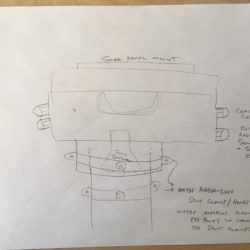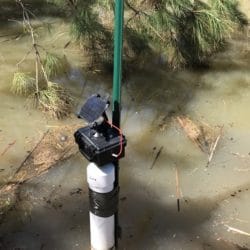Home › Forums › Infrastructure and Equipment › Sonic sensors and their enclosures
- This topic has 4 replies, 2 voices, and was last updated 2018-05-01 at 11:58 AM by
 Kevin Stokes.
Kevin Stokes.
-
AuthorPosts
-
-
2018-03-29 at 11:22 AM #12205This thread was originally posted as a status update in “Researchers forum”, and I think it could be helpful to index it as a topic in this forum.
@kryan originally asked:
This thread was originally posted as a status update in “Researchers forum”, and I think it could be helpful to index it as a topic in this forum.@kryan originally asked:
I am searching for recommendations and resources to construct a low-cost ultrasonic water level sensor for use with trapezoidal flumes on small streams@ fisherba replied:
Hi Kevin, we are using and like the sensors from Maxbotix. Here’s an old blog post by @shicks to see one compact enclosure option:
https://envirodiy.org/ultrasonic-water-depth-sensor/.
https://www.maxbotix.com/Ultrasonic_Sensors/MB7389.htm has a range of 30-500 cm.
https://www.maxbotix.com/Ultrasonic_Sensors/MB7386.htm has a range of 50-1000 cm.
https://www.maxbotix.com/Ultrasonic_Sensors/MB7955.htm makes temperature compensation integrated with the MaxSonar (and there’s a solder it yourself kit for 1/3 cost).Scripts are available in the modular sensor repo:
https://github.com/EnviroDIY/ModularSensors
Also notable, we like to drill and tap plastic enclosures and screw the MaxSonar straight into the enclosure. https://github.com/EnviroDIY/EnviroDIY_Mayfly_Logger/blob/master/hardware/1120Pelican_enviroDIY_5.pdf
Let me know if you have other questions.@klstokes added:
I have a couple of high school students making a water-depth sensor with the MB7389 ultrasonic sensor and a Mayfly data logger. The information you posted has been very helpful. We are also using the Pelican 1120 case. The problem we are having is attaching the case/MB7389 to the top of the 4″ PVC pipe that we are using for a stilling well. Any suggestions?fisherba replied:
Hi Kevin, I’m not sure about an elegant way to mount a pelican case to the pipe. My current cases are all pole mounted with two 10″ zinc mending plates mounted to the back of the Pelican case using bonded sealing washers to keep the case dry. Then the mending plates are mounted to a post in the ground. If you have only ultrasonic sensors on the well, I think what @shicks did here is very elegant and way less expensive than Pelican cases: https://envirodiy.org/ultrasonic-water-depth-sensor/@kevinstokes replied:
Thank you. I checked out the link, that is very nice. Right now we only have the ultrasonic sensor, but I wanted to add temperature sensors for water and air. In the future, we might add a rain gauge.fisherba replied:
Kevin, I was just thinking, how about mounting a PVC end cap to the back of the pelican case (so the door of the case is on top) and drill and tap the PVC and case to accommodate the ultrasonic sensor? It would look something like the one linked above, but roomier. Then you have the case mounted as a sort of well cap and you have room to add additional sensors as needed to the system over time (by tapping with cord grips as needed). It seems like it would be pretty trivial to create a clamping system on the outside of the the well to hold the pelican case/cap on the top of the well in a stable way. The 1120 case is pretty small.I’m attached a very crude sketch of what I have in mind. I suspect your student will greatly improve upon it!
Attachments:
-
2018-04-27 at 5:18 PM #12270Thank you. The students came up with almost the same idea; the attached image is their first design. We found some PVC pipe fittings that we think will help and we are working on a new design. BasicalThank you. The students came up with almost the same idea; the attached image is their first design. We found some PVC pipe fittings that we think will help and we are working on a new design. Basically, we found a 4″ PVC cap that has a flat top which we think will make it easier to attach the Pelican case.
Attachments:
-
2018-04-28 at 4:09 PM #12272
Thanks for sharing! It looks great!
It looks like it holds the potential of flooding. Have you installed submersible cord grips? https://www.mcmaster.com/#standard-cord-grips/=1cm2uit
Beth
-
2018-05-01 at 8:21 AM #12282
-
2018-05-01 at 11:58 AM #12284This first version had no cord grips. The students used silicone sealant but water was able to seep in somewhere. They say it didn’t flood. I have since purchased cord grips, http://www.newark.cThis first version had no cord grips. The students used silicone sealant but water was able to seep in somewhere. They say it didn’t flood. I have since purchased cord grips, http://www.newark.com/jacob/50007m12pasw-f/cable-clamp-gland-polyamide-thrd/dp/15M6172?ost=1168781&ddkey=http%3Aen-US%2FElement14_US%2Fsearch. Like the ones you suggested, these are also IP68 rated, but a little cheaper. However, the cord grips from McMaster seem better since they have an additional o-ring, are available in many different sizes to accommodate different cable diameters, and have NPT threads.
-
-
AuthorPosts
- You must be logged in to reply to this topic.

 Welcome to EnviroDIY, a community for do-it-yourself environmental science and monitoring. EnviroDIY is part of
Welcome to EnviroDIY, a community for do-it-yourself environmental science and monitoring. EnviroDIY is part of 
